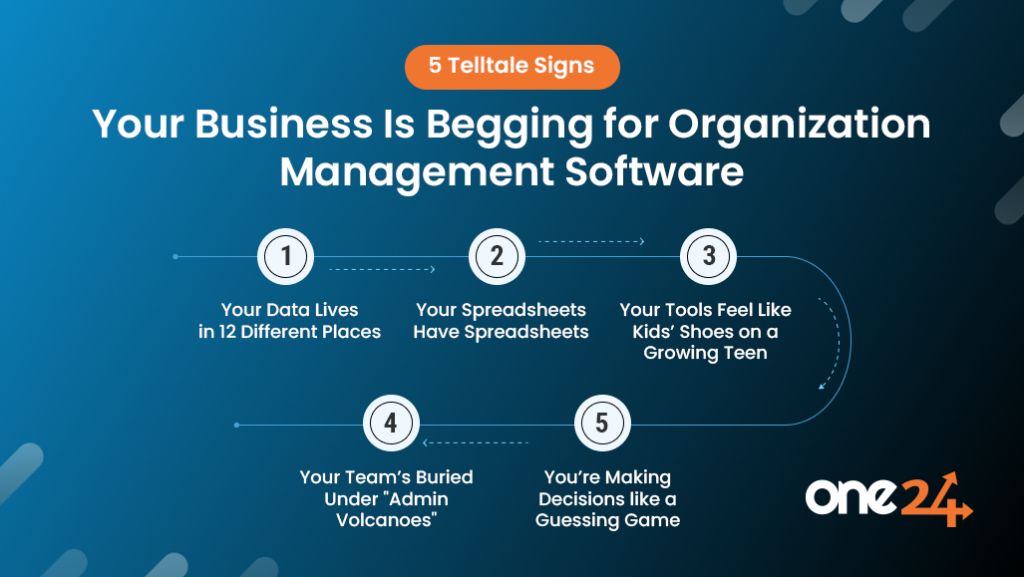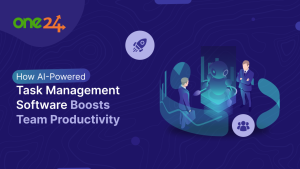Let’s be real, running a business today is like juggling chainsaws while riding a unicycle. What worked when you were a scrappy startup (hello, Excel sheets and sticky notes) starts crumbling once you hit growth mode. Missed deadlines, duplicate work, and that “Where’s the client contract?” panic became weekly occurrences. You’re not disorganized, you’ve just outgrown duct-tape solutions. Here’s how to spot when it’s time to upgrade to organization management software before things spiral.
1. Your Data Lives in 12 Different Places (And None Are the Right One)
Ever played detective hunting for a client’s phone number buried in Slack, a PDF invoice, and someone’s handwritten meeting notes? Scattered data isn’t just annoying, it’s costing you money. A sales rep quotes outdated pricing because the “master” spreadsheet wasn’t updated. A project timeline gets derailed because the Gantt chart in the Project Manager’s email is three versions behind.
Why it’s a problem: Disorganization breeds mistakes. When your team can’t trust the data they’re using, decisions get made on guesses, not facts.
How software fixes it: Imagine one searchable hub where contracts, customer histories, and inventory levels live, with real-time updates. No more “I thought you had that file!” moments.
Pro move: Look for tools with OCR (optical character recognition) to digitize paper trails during setup.
2. Your Spreadsheets Have Spreadsheets (And It’s a Nightmare)
Ah, spreadsheets. They’re like that ex who was great at first but now just complicates your life. Finance tracks expenses in Google Sheets. Sales pipelines live in Airtable. HR keeps PTO requests on hold. Is that a printed calendar?
Why it’s a problem: Disconnected systems create blind spots. Marketing launches a campaign without realizing Operations is swamped. Leadership can’t see the big picture because data’s trapped in departmental silos.
How software fixes it: A unified platform acts like a central nervous system. When sales close a deal, inventory auto-adjusts. Project delays trigger alerts to adjust timelines.
Real-life win: A bakery chain ditched 14 (!) separate sheets for ingredient orders and reduced stock waste by 40% in three months.
3. Your Tools Feel Like Kids’ Shoes on a Growing Teen
Remember when your “CRM” was a Gmail label and “project management” meant CC’ing everyone? Those Band-Aid solutions stop fitting fast. Maybe your accounting software can’t handle multi-location taxes, or your team’s drowning in app overload.
Why it’s a problem: Patchwork tools create friction. New hires take weeks to learn your cobbled-together system. Custom reports require IT voodoo and prayers.
How software fixes it: Scalable platforms grow with you. Need to add warehouses? Integrate with Shopify? No coding required.
Watch for: APIs that let your tools “talk” to each other, like syncing your email marketing stats with sales data automatically.
4. Your Team’s Buried Under “Admin Volcanoes”
Here’s a fun experiment, Track how many hours your staff spends on:
- Typing the same client info into 5 forms
- Chasing approvals via email
- Manually updating project statuses
If it’s more than 10 hours/week, you’re basically paying people to do robot work.
Why it’s a problem: Burnout city. Talented employees quit when 70% of their day is mindless data entry.
How software fixes it: Automation handles the grunt work. Set rules like:
- “When a deal hits ‘Closed-Won,’ generate the contract.”
- “Alert the warehouse if inventory dips below 50 units.”
Bonus: Employees actually get to use their brains for strategy and creativity.
5. You’re Making Decisions like a Guessing Game
“How’s Q3 looking?” “Uh… maybe up? Let me check last month’s PDFs.” If your “analytics” involve stitching together screenshots, you’re flying blind.
Why it’s a problem: Late insights lead to missed opportunities. By the time you spot a sales dip, it’s too late to course-correct.
How management software fixes it:
Real-time dashboards show:
- Cash flow trends
- Team bandwidth
- Customer churn risks
Power move: Schedule weekly “data huddles” to review metrics and pivot fast.
The Conclusion
If two or more of these resonate with you, you’re not failing; you’re outgrowing. Organization management software isn’t just about tidying up; it’s about unlocking speed and confidence.
Next steps:
- Audit pain points (e.g., “We lose 15 hours/week on manual payroll”)
- Test-drive tools (Consult us!)
- Prioritize ease of use (If your team won’t adopt it, it’s worthless.)
Still on the fence? Ask yourself: How much is disorganization costing us in stress, errors, and lost deals? The answer’s usually scarier than the software learning curve.
Contact us today or book a free demo to see One24 in action.







